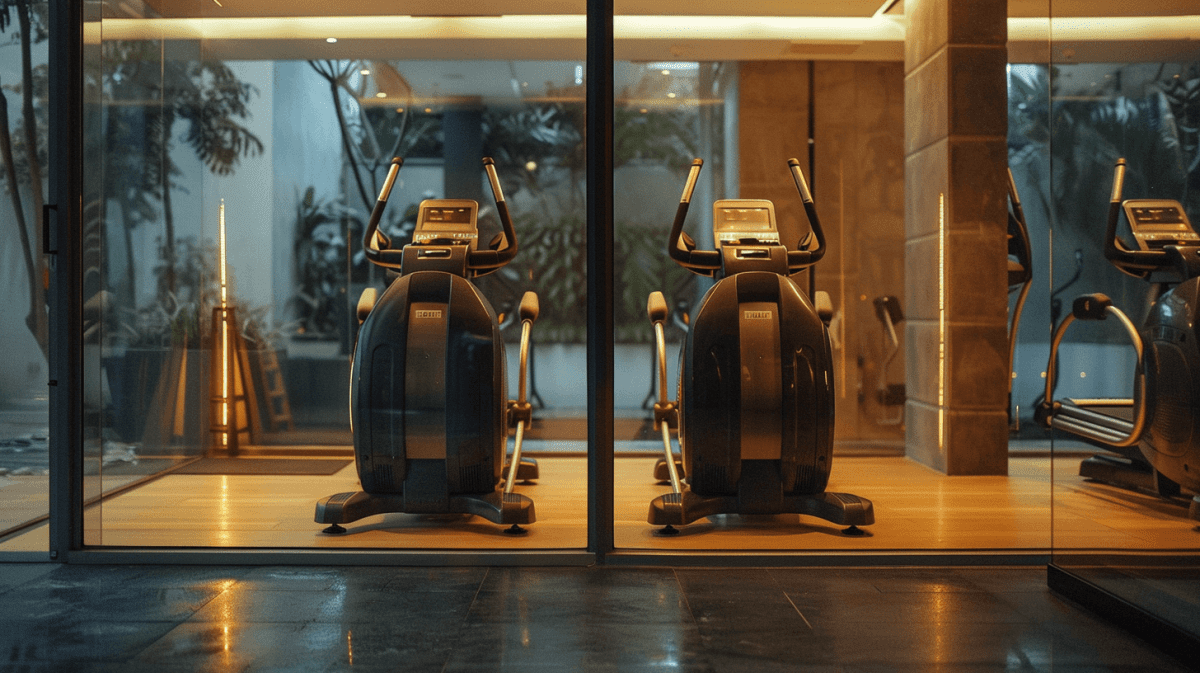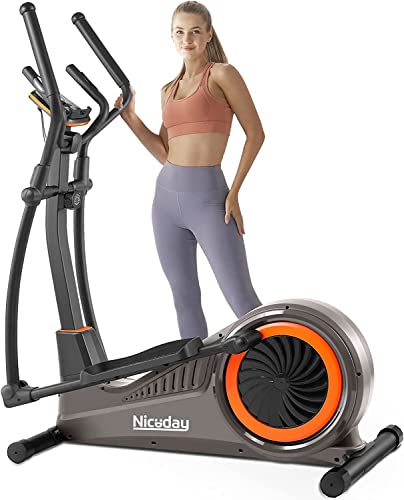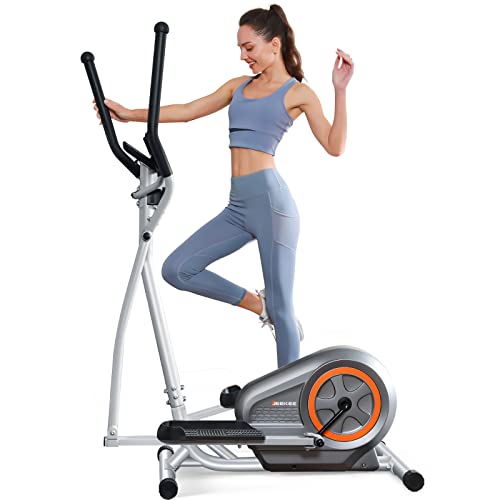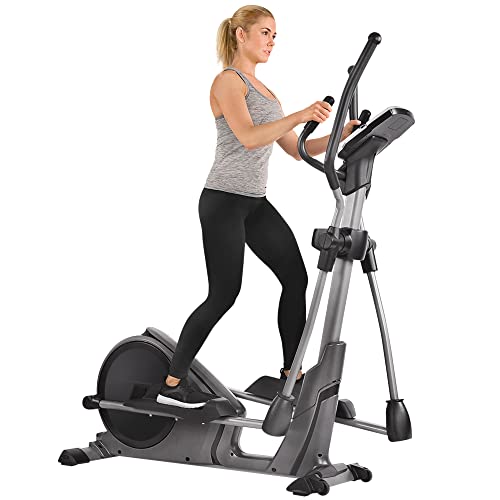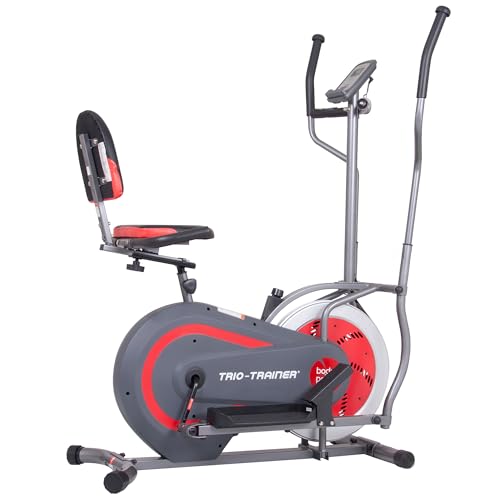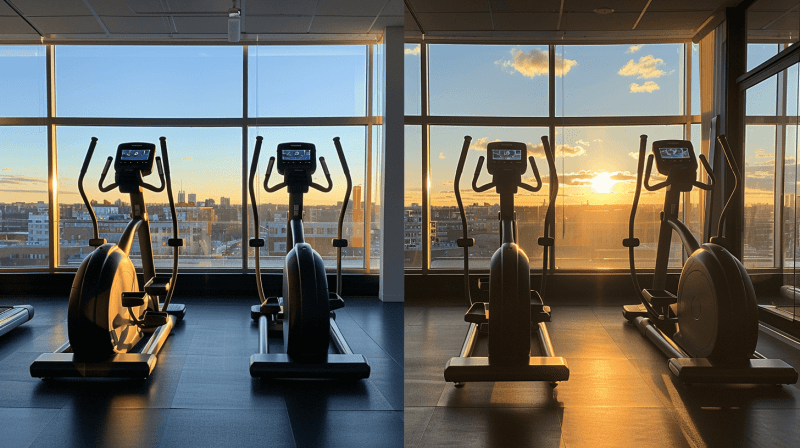You'll notice the difference between walking and using an elliptical machine from your very first stride. While a casual stroll allows your body to move naturally with minimal effort, the elliptical demands more from your muscles and cardiovascular system. This fitness equipment isn't just another walking substitute - it's an extensive workout tool that challenges your body in ways that regular walking can't match. Understanding these key differences can help you maximize your exercise routine and achieve your fitness goals more effectively. Let's explore why this popular machine puts your body through a more rigorous workout than your daily walk.
Key Takeaways
-
Elliptical machines engage multiple muscle groups simultaneously through synchronized arm and leg movements, unlike walking's lower-body focus.
-
Constant mechanical resistance creates a more demanding workout than walking's natural momentum-based movement.
-
The fixed stride pattern and controlled motion require more coordination and balance than walking's natural gait.
-
Core muscles work harder to maintain stability and proper form during the elliptical's circular motion pattern.
-
Upper body engagement through push-pull handle movements adds significant intensity compared to arms swinging freely while walking.
Full-Body Muscle Engagement
During an elliptical workout, you'll engage considerably more muscle groups than walking, making it a more demanding cardiovascular exercise. The elliptical machine creates a unique full-body workout through its synchronized arm and leg motion, which activates muscles from your shoulders down to your calves in a coordinated pattern.
When you're using the elliptical machine, your upper body remains consistently engaged as you push and pull the handles, working your chest, shoulders, and back muscles in ways that walking simply can't match. The controlled motion requires greater activation of your core muscles to maintain proper form and stability throughout your workout session.
You'll experience increased muscle engagement through the machine's adjustable resistance and incline settings, which allow you to intensify your workout beyond what's possible with regular walking. The continuous, fluid motion of the elliptical creates a more structured exercise environment where your muscles work harder to maintain the prescribed path of movement, unlike walking's natural gait pattern. This combination of greater muscle recruitment and controlled movement patterns explains why you'll likely find the elliptical more challenging than a standard walk. For a moderate 30-minute workout, a 170 calorie burn can be achieved by a 150-pound person, making it an efficient exercise choice.
Resistance and Energy Output
On an elliptical machine, you'll expend substantially more energy than walking due to the constant resistance provided by the machine's mechanics. The continuous push and pulling motions of both your arms and legs create a demanding workout that keeps your muscles engaged throughout the entire session, unlike walking's natural alternating rest periods between steps.
You'll find that the elliptical's adjustable resistance levels give you greater control over your workout intensity, allowing you to challenge yourself beyond what traditional walking can offer. As you increase the resistance, your muscles must work harder to maintain the same motion, leading to higher energy expenditure and an elevated heart rate.
The machine's design requires you to maintain a consistent stride pattern while managing resistance from both the pedals and arm handles. This combination of factors makes the elliptical a more challenging cardiovascular exercise than walking, as your body must constantly work against the machine's resistance. You can further intensify your workout by adjusting the resistance levels higher, making it an effective tool for progressive fitness improvement. The full-body workout engages multiple muscle groups simultaneously while remaining gentle on your joints, making it an ideal choice for comprehensive fitness training.
Controlled Motion Versus Natural Movement
While walking comes naturally to most people, the elliptical machine demands a more coordinated and controlled movement pattern that challenges your body in different ways. When comparing elliptical vs walking, you'll notice that the machine requires you to synchronize your upper and lower body movements in a fixed pattern, unlike the natural gait you use while walking or on a treadmill.
Your fitness level plays an essential role in determining whether elliptical or walking is better for weight loss and overall fitness goals. The elliptical's fixed stride length and preset resistance levels create a more structured workout environment, forcing your muscles to adapt to a specific motion pattern. Your feet remain planted on the pedals throughout the exercise, which limits natural ankle movement but intensifies the engagement of other muscle groups.
Maintaining proper upright posture with shoulder blades gently pulled back is crucial for maximizing the effectiveness of your elliptical workout.
- You'll feel a deeper muscle engagement as your body adapts to the elliptical's circular motion
- Your coordination will be tested as you sync arm and leg movements
- You might experience initial awkwardness adjusting to the machine's fixed patterns
- Your core muscles will work harder to maintain proper form
- You'll notice the difference between natural walking movements and the elliptical's controlled motion
Heart Rate and Cardiovascular Demand
This elevated cardiovascular response contributes to greater health benefits and more Calories burned during your fitness routine, making the elliptical an effective choice for weight management and cardiovascular conditioning. The low-impact design of elliptical machines allows users to achieve these cardiovascular benefits while minimizing strain on their joints. This elevated cardiovascular response contributes to greater health benefits and more Calories burned during your fitness routine, making the elliptical an effective choice for weight management and cardiovascular conditioning.
Balance and Core Stabilization
Balance becomes a significant factor when you step onto an elliptical machine, requiring greater core engagement than a typical walk. Your body's stabilizing muscles, particularly in the abdominal, back, and hip regions, must work continuously to maintain proper form and posture throughout the exercise. The elliptical's unique circular motion challenges your balance and coordination more intensely than walking's natural linear movement.
The increased core muscle activation you'll experience on an elliptical happens because your body needs to constantly adjust to the machine's moving pedals. You'll find that maintaining stability requires focused attention and engagement of your core musculature, making the workout more demanding than a regular walk.
- Your core muscles fire up immediately as you try to find your rhythm on the moving pedals
- You'll feel your abs, back, and hips working together to keep you steady
- Your body naturally activates more muscles to prevent wobbling or swaying
- Your balance and stability improve with each session as your core gets stronger
- Your posture becomes more aligned as your stabilizing muscles adapt to the movement
Unilateral movements during elliptical workouts strengthen the stabilizing muscles while promoting better balance control and proper body alignment.
Frequently Asked Questions
Why Is the Elliptical Harder Than Walking?
You'll find the elliptical more challenging because it combines increased resistance levels, targets multiple muscle groups, and maintains consistent stride patterns. Plus, variable incline settings and full-body engagement demand more energy than walking.
Is a Mile on the Elliptical the Same as Walking a Mile?
Ever wondered about the difference? No, a mile on the elliptical isn't equal to walking a mile. You'll burn more calories on the elliptical due to increased resistance levels and total muscle engagement.
Is Walking or the Elliptical Better for Weight Loss?
The elliptical offers higher calorie burn and full-body engagement for weight loss, but you'll see the best results with whichever activity you'll stick to consistently. Both are effective when paired with proper nutrition.
What Are the Negatives of the Elliptical Machine?
Since the days of yore, ellipticals can cause joint stress, muscle imbalances, and poor posture. You'll face difficulty maintaining proper form, risk overuse injuries, and won't get natural stride movements like you're used to.
Conclusion
While walking remains a natural form of movement, you'll find the elliptical machine provides a more rigorous full-body experience with its unique combination of resistance and synchronized motion. You're not just moving forward; you're engaging in a carefully orchestrated dance of muscle groups, challenging your body's natural patterns. When you're seeking to maximize your workout efficiency, the elliptical's heightened demands on balance, strength, and cardiovascular endurance make it a more intensive choice than a casual stroll.
